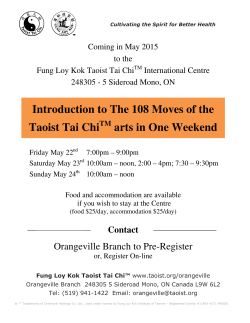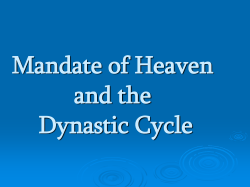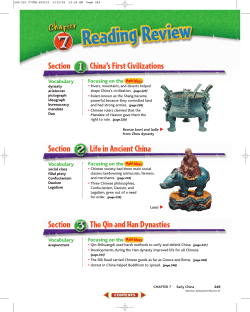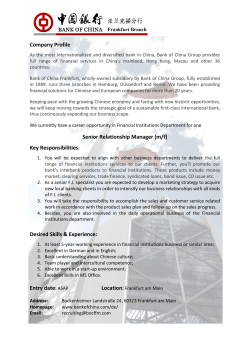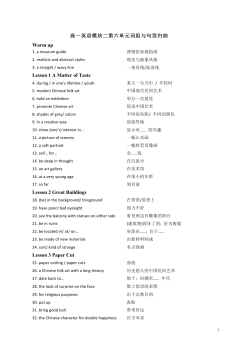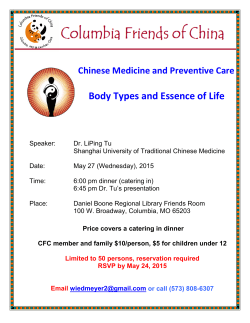
Taoism and Chi Culture - Religion
1 CHT 3513 (051E)/REL 3938 (036G)/MEM 3931 (0439) Taoism and Chinese Culture All readings are in English Spring 2015 Class time: T 7 (1:55-2:45pm) /R 7-8 (1:55-3:50pm) Classroom: MAT 0105 Instructor: Richard G. Wang E-mail: rwang1@ufl.edu Telephone: 846-2071 Office: Pugh Hall 359 Office hours: Tuesday 3:00-5:00pm, and Thursday 4:00-5:00pm, or by appointment Course Description Taoism (now often written “Daoism”) is a Chinese cultural tradition focused primarily on methods, strategies and communities for individual and socio-political integration with the totality of reality, including its transcendent dimensions. Taoism encompasses a broad array of moral, social, philosophical, religious and cultural ideas, values, and practices. Like other religions around the world, Taoism included some contemplatives, whose orientation often seems attractive to modern people— particularly to Westerners looking for alternatives to their own cultural traditions. In this course, you will learn that Taoism is an ancient and immense tradition of great subtlety and complexity. You will see how its many dimensions evolved to answer the needs of people of different periods and different propensities, and you should learn respect for, and understanding of, the teachings and practices of all those people. Taoism is not some abstract "timeless wisdom" that simply consists of a set of warm, fuzzy ideas. Rather, Taoism is a specific set of cultural traditions that evolved within the historical context of ancient, medieval, and modern China, evolving to meet the spiritual needs of people in specific historical situations. The multi-sources and complexity of Taoist belief systems and ritual practice, and the influence of Taoism upon Chinese thought, religion, art, culture and society will also be covered. Course Format and Prerequisites This course is a combination of lectures and discussions. Students are encouraged and expected to engage in class discussions and critical analysis of the course materials, especially during the discussion sessions. There are no formal prerequisites and no knowledge of Chinese language is required. Course Requirements Students will be asked to attend regularly, and read the assigned materials for each class meeting. In addition, each student is required to make two presentations (15-20 minutes). Two tests will be given throughout the course. There are also two “Short Papers” (3 pp. each) and one final takehome exam (4-5 pp.). The final take-home exam (4-5 pages) will be due on Monday, April 27, 2015, at 5:00pm. Late submission of the take-home exam will not be read or graded unless permission is given beforehand. It is the student’s responsibility to communicate to me any 2 special needs and circumstances, as well as to provide written documentation for excused absences. Required Texts Victor Mair, trans., Tao Te Ching: The Classic Book of Integrity and the Way. New York: Bantam, 1990. Victor Mair, trans., Wandering on the Way: Early Taoist Tales and Parables of Chuang Tzu. Honolulu: University of Hawai‘i Press, 1994. Isabelle Robinet, Taoism: Growth of a Religion, trans. Phyllis Brooks. Stanford: Stanford University Press, 1997. Eva Wong, trans. Seven Taoist Masters: A Folk Novel of China. Boston: Shamnhala, 990. In addition to the textbooks, there are other required readings in the Automating Reserves (Ares, available from Course Reserves under the University of Florida Libraries), or on reserve in Library West. The Ares materials are arranged by authors. Course Assignments 1. Class participation & preparedness (you will be assigned issues to address in the upcoming reading) (20%). Absences: Three “free” absences are allowed for medical and other emergencies. For each subsequent absence, your final grade will be affected. 2. Two tests (30%). 3. One or two presentations (10%). 4. Two short papers (3 pp. each) (20%). 5. Take-home final exam (4-5 pages) (20%). Grading Scale A=93-100%; A-=90-92%; B+=87-89%; B=83-86%; B-=80-82%; C+=77-79%; C=73-76%; C=70-72%; D+=67-69%; D=63-66%; D-=60-62%; E=below 60%. S is equivalent to C or better. Passing Grades and Grade Points According to university guidelines, letter grades will convert to GPA as follows: A = 4.0; A= 3.67; B+ = 3.33; B= 3; B- = 2.67; C+ = 2.33; C = 2.0; C- = 1.67; D+ = 1.33; D = 1.0; D- = .67; E = 0; WF = 0; I = 0; NG = 0; S-U = 0 Students must earn a grade of C or higher to meet their major, minor, or General Education requirements. The S-U option is not counted toward their major or minor degree, nor General Education requirements. Policy for Requesting a Letter of Recommendation 1. I only write letters of recommendation for top students (B+ and above) in my classes; and 2. I only write letters of recommendation for either the Chinese majors who have taken at least one course with me, or non-majors who have taken two courses with me. “Students requesting classroom accommodation must first register with the Dean of 3 Students Office. The Dean of Students Office will provide documentation to the student who must then provide this documentation to the Instructor when requesting accommodation.” Short papers See “Guidelines for Short Papers.” Discussion Students are expected to prepare for the reading assignment prior to the date that is marked in the Syllabus, and generate at least one question about the reading for discussion in class. Everyone is expected to actively participate in the discussion. Course outline (28 class meetings) Introduction Wk 1 1/6 Introduction to the course 1/8 Background to Daoism Isabelle Robinet, Taoism: Growth of a Religion, pp. 1-23; Stephen Bokenkamp, “Daoism: An Overview,” in Encyclopedia of Religion, 2nd ed., ed. Lindsay Jones (Detroit: Macmillan, 2005), pp. 2176-92; Gil Raz, The Emergence of Daoism: Creation of Tradition (London: Routledge, 2012), pp. 1-21. Foundations Wk 2 1/13 “The Elders” — The Daode jing (Tao te ching) Mair, trans., Tao Te Ching, pp. 59-92; Benjamin Schwartz, “The Thought of the Tao-te-ching,” in Lao-tzu and the Tao-te-ching, ed. Livia Kohn and Michael LaFargue (Albany: State University of New York Press, 1998), pp. 189-210. 1/15 The Dao that can’t be told (Daode jing continued), and Discussion Mair, trans., Tao Te Ching, pp. 93-105, 3-25; 26-55; Max Kaltermark, Lao Tzu and Taoism, trans. Roger Greaves (Stanford: Stanford University Press, 1969), pp. 47-69, 107-13; Livia Kohn, “The Tao-te-ching in Ritual,” in Lao-tzu and the Tao-te-ching, ed. Livia Kohn and Michael LaFargue, pp. 143-59. Wk 3 1/20 The “Useless words” of Zhuangzi (“Chuang-tzu”) Mair, trans., Wandering on the Way, pp. 3-41; 4 A. C. Graham, Disputers of the Tao: Philosophical Argument in Ancient China (La Salle: Open Court, 1989), pp. 170-211. 1/22 At ease in perfect happiness (Zhuangzi continued), and Discussion Mair, trans., Wandering on the Way, pp. 42-71, 90-101, 152-73; Victor Mair, “The Zhuangzi and Its Impact,” in Daoism Handbook, ed. Livia Kohn (Leiden: Brill, 2000), pp. 30-52; Michael Saso, “The Zhuangzi neipian: A Daoist Meditation,” in Experimental Essays on Zhuangzi, ed. Victor Mair (Dunedin: Three Pines Press, 2010), pp. 137-53. Wk 4 1/27 Health, immortality, cosmos, gods, and governance Isabelle Robinet, Taoism: Growth of a Religion, pp. 35-50, 91-113; Livia Kohn, ed., The Taoist Experience: An Anthology (Albany: State University of New York Press, 1993), pp. 290-99, 351-58. 1/29 Discussion Michael Loewe, Chinese Ideas of Life and Death: Faith, Myth and Reason in the Han Period (202 BC-AD 220) (London; Allen & Unwin, 1982), pp. 17-24, 38-47, 80-113, 159-69; N. J. Girardot, Myth and Meaning in Early Taoism: The Theme of Chaos (hun-tun) (Berkeley and Los Angeles: University of California Press, 1974), pp. 21-43, 257-74; Ute Engelhardt, “Longevity Techniques and Chinese Medicine,” in Daoism Handbook, pp. 74108; Nathan Sivin, “Health Care and Daoism,” Daoism: Religion, History and Society 3 (2011): 1-14. Formation Wk 5 2/3 Celestial Master Daoism Isabelle Robinet, Taoism: Growth of a Religion, pp. 53-77; Grégoire Espesset, “Later Han Religious Mass Movements and the Early Daoist Church,” in Early Chinese Religion, Part One: Shang through Han (1250 BC-220 AD), ed. John Lagerwey and Marc Kalinowski (Leiden and Boston: Brill, 2009), v. 2, pp. 1061-1102. Further reading Peter Nickerson, “The Southern Celestial Masters,” in Daoism Handbook, pp. 256-82; Masayoshi Kobayashi, “The Celestial Masters under the Jin and Liu-Song Dynasties,” Taoist Resources 4 (1992): 17-44; Livia Kohn, “The Northern Celestial Masters,” in Daoism Handbook, pp. 283-308. 2/5 Major schools of the middle ages: Shangqing (Highest Clarity), and Discussion Isabelle Robinet, Taoism: Growth of a Religion, pp. 114-48; Stephen Bokenkamp, “Declarations of the Perfected,” in Religions of China in Practice, ed. Donald S. Lopez, Jr. (Princeton: Princeton University Press, 1996), pp. 166-79; Paul W. Kroll, “Seduction Songs of One of the Perfected,” in ibid., pp. 180-87; Isabelle Robinet, Taoist Meditation: The Mao-shan Tradition of Great Purity, trans. Julian F. Pas and Norman J. Girardot (Albany: State University of New York Press, 1993), pp. 19-54; 5 Livia Kohn, ed., The Taoist Experience, pp. 204-14. Wk 6 2/10 Major schools of the middle ages: Lingbao (Numinous Treasure) Isabelle Robinet, Taoism: Growth of a Religion, pp. 149-83; Stephen Bokenkamp, “The Silkworm and the Bodhi Tree: The Lingbao Attempt to Replace Buddhism in China and Our Attempt to Place Lingbao Daoism,” in Religion and Chinese Society: Volume 1, Ancient and Medieval China, ed. John Lagerwey (Hong Kong: The Chinese University Press, 2004), pp. 317-39; Livia Kohn, ed., The Taoist Experience, pp. 43-48. 2/12 Ethics and community, and Discussion Barbara Hendrischke, “The Concept of Inherited Evil in the Taiping Jing,” East Asian History 2 (1991): 1-30; Barbara Hendrischke and Benjamin Penny, “The 180 Precepts Spoken by Lord Lao: A Translation and Textual Study,” Taoist Resources 6.2 (1996): 17-29; Terry Kleeman, “Community and Daily Life in the Early Daoist Church,” in Early Chinese Religion, Part Two: The Period of Division (220-589 AD), ed. John Lagerwey and Lü Pengzhi (Leiden and Boston: Brill, 2010), vol. 1, pp. 395-436. Peter Nickerson, “Abridged Codes of Master Lu for the Daoist Community,” in Religions of China in Practice, ed. Donald S. Lopez Jr. (Princeton: Princeton University Press, 1996), pp. 347-59; Livia Kohn, Daoism and Chinese Culture (Cambridge, MA: Three Pines Press, 2001), pp. 61-80. Wk 7 *2/17 Creation and the pantheon Stephan Peter Bumbacher, “Cosmic Scripts and Heavenly Scriptures: The Holy Nature of Taoist Texts,” COSMOS, The Yearbook of the Traditional Cosmology Society 11.2 (1995): 13953; Stephen Bokenkamp, “Daoist Pantheons,” in Early Chinese Religion, Part Two: The Period of Division (220-589 AD), ed. John Lagerwey and Lü Pengzhi, vol. 2, pp. 1169-1203. *Deadline, #1 written analysis (s-paper) of any theme to date (3 pp.) Further reading Stephen Bokenkamp, “Word as Relic in Medieval Daoism,” in Medieval and Early Modern Devotional Objects in Global Perspective: Translations of the Sacred, ed. Elizabeth Robertson and Jennifer Jahner (New York: Palgrave Macmillan, 2010), pp. 21-35. John Lagerwey, “A Brief History of the Pantheon: Ancestors and Gods in State and Local Religion and Politics,” in idem, China: A Religious State (Hong Kong: Hong Kong University Press, 2010), pp. 19-55. 2/19 Daoist messianism and imperial adaptations, and Discussion Anna Seidel, “The Image of the Perfect Ruler in Early Taoist Messianism: Lao-tzu and Li Hung,” History of Religions 9.2-3 (1970): 216-47; Richard Mather, “K’ou Ch’ien-chih and the Taoist Theocracy at the Northern Wei Court 6 425-451.” In Facets of Taoism: Essays in Chinese Religion, ed. Holmes Welch and Anna Seidel (New Haven: Yale University Press, 1979), pp. 103-22; Charles Benn, “Religious Aspects of Emperor Hsüan-tsung’s Taoist Ideology,” in Buddhist and Taoist Practice in Medieval Chinese Society, ed. David Chappell (Honolulu: University of Hawai‘i Press, 1987), pp. 127-45. John Lagerwey, “Taoism and Political Legitimacy,” in idem, Taoist Ritual in Chinese Society and History, pp. 253-64; Robert Hymes, “The Bureaucratic Model: A Speculation,” in idem, Way and Byway: Taoism, Local Religion, and Models of Divinity in Sung and Modern China (Berkeley and Los Angeles: University of California Press, 2002), pp. 171-205.) Further reading Catherine Despeux, “Talismans and Sacred Diagrams,” in Daoism Handbook, pp. 498-540. Wk 8 2/24 Daoist Canon Kristofer Schipper, “General Introduction,” in The Taoist Canon: A Historical Companion to the Daozang, ed. Kristofer Schipper and Franciscus Verellen (Chicago: University of Chicago Press, 2004), pp. 1-52; Ōfuchi Ninji, “The Formation of the Taoist Canon,” in Facets of Taoism: Essays in Chinese Religion, ed. Holmes Welch and Anna Seidel, pp. 253-67. Development 2/26 New texts and cults: Foundation of later Daoism Lowell Skar, “Ritual Movements, Deity Cults, and the Transformation of Daoism in Song and Yuan Times,” in Daoism Handbook, pp. 413-63; Edward L. Davis, Society and the Supernatural in Song China (Honolulu: University of Hawai‘i Press, 2001), pp. 21-66; Isabelle Robinet, Taoism: Growth of a Religion, pp. 212-56. Further reading Livia Kohn, Daoism and Chinese Culture, pp. 171-85; Zhang Guangbao, “History and Early Lineages,” in Internal Alchemy: Self, Society, and the Quest for Immortality, ed. Livia Kohn and Robin R. Wang (Magdalena: Three Pines Press, 2009), pp. 53-70; Li Yangzheng, History of Chinese Taoism, trans. Yan Zhonghu (Beijing: Foreign Languages Press, 2009), pp. 184-212. Wk 9 Spring Break Wk 10 3/10 Test 1 (not covering the session “Development”) 3/12 Quanzhen (Complete Perfection) order 7 Louis Komjathy, Cultivating Perfection: Mysticism and Self-transformation in Early Quanzhen Daoism (Leiden and Boston: Brill, 2007), pp. 33-62; Wong, trans. Seven Taoist Masters: A Folk Novel of China, pp. 1-53. Wk 11 3/17 Seven Taoist Masters: A Folk Novel of China Wong, trans. Seven Taoist Masters: A Folk Novel of China, pp. 54-107. 3/19 Seven Taoist Masters: A Folk Novel of China, and Discussion Wong, trans. Seven Taoist Masters: A Folk Novel of China, pp. 108-76; Louis Komjathy, Cultivating Perfection: Mysticism and Self-transformation in Early Quanzhen Daoism, pp. 147-73. Wk 12 3/24 Zhengyi (Orthodox Unity) order Vinvent Goossaert, The Taoists of Peking, 1800–1949: A Social History of Urban Clerics (Cambridge, Mass.: Harvard University Asia Center, 2007), pp. 23-47; Chen Yaoting, “Zhengyi (Orthodox Unity; Correct Unity),” in The Encyclopedia of Taoism, ed. Fabrizio Pregadio, v. 2, pp. 1258-60; Vincent Goossaert, “Daoism (Zhengyi tradition),” in Encyclopedia of Contemporary Chinese Culture, ed. Edward L. Davis (New York and London: Routledge, 2005), pp. 135-36; Richard G. Wang, “Qiyunshan as a Replica of Wudangshan and the Religious Landscape of the Ming Empire,” Journal of Chinese Religions 42.1 (2014): 28-66; Vincent Goossaert, “Bureaucratic Charisma: The Zhang Heavenly Master Institution and Court Taoists in Late-Qing China,” Asia Major 3rd series, 17.2 (2004): 121-59 3/26 No class – take-home assignment Russell Kirkland, Taoism: The Enduring Tradition (New York and London: Routledge, 2004), pp. 144-71; Chao Shin-yi, “Daoist Examinations and Daoist Schools,” Journal of Chinese Religions 31 (2003): 1-31. Wk 13 3/31 Celestial Master institution, and Discussion Russell Kirkland, “Tianshi (Celestial Master),” in The Encyclopedia of Taoism, ed. Fabrizio Pregadio (New York and London: Routledge, 2008), v. 2, pp. 979-81; Vincent Goossaert, “Longhu shan [Mount Longhu (Jiangxi)],” in The Encyclopedia of Taoism, ed. Fabrizio Pregadio, v. 1, pp. 702-4; Vincent Goossaert, “The Heavenly Master, Canonization, and the Daoist Construction of Local Religion in Late Imperial Jiangnan,” Cahiers d’Extrême-Asie 20 (2011): 229-45; Vincent Goossaert, “Daoism and Local Cults in Modern Suzhou: A Case Study of Qionglongshan,” in Zhongguo minjian zongjiao minjian xinyang yanjiu zhi Zhong-Ou shijiao (Chinese and European Perspectives on the Study of Chinese Popular Religions) (Taibei: Boyang wenhua shiye, 2012), pp. 200-28. 8 Further reading Franciscus Verellen, “The Twenty-four Dioceses and Zhang Daoling: The Spatioliturgical Organization of Early Heavenly Master Taoism,” in Pilgrims, Patrons, and Place: Localizing Sanctity in Asian Religions, eds. Phyllis Granoff, Koichi Shinohara, and Jack Laughlin (Vancouver: University of British Columbia Press, 2003), pp. 15-67. *4/2 Daoism and society, and Discussion Kristofer Schipper, “Neighborhood Cult Associations in Traditional Tainan,” in The City in Late Imperial China, ed. G. William Skinner (Stanford: Stanford University Press, 1977), pp. 651-78; Kenneth Dean, Taoist Ritual and Popular Cults of Southeast China (Princeton: Princeton University Press, 1993), pp. 21-53; Richard G. Wang, “A Local Longmen Lineage in Late Ming-Early Qing Yunnan,” in Quanzhen Daoists in Chinese Society and Culture, 1500-2010, eds. Xun Liu and Vincent Goossaert (Berkeley: Institute of East Asian Studies, UC Berkeley, 2014), pp. 235-68; *Deadline, #2 written analysis (s-paper) of any theme to date (3 pp.) Further reading Kristofer Schipper, “Taoist Ritual and Local Cults of the Tang Dynasty,” in Tantric and Taoist Studies in Honour of R. A. Stein, ed. Michel Strickmann (Brussels: Institut Belge des Hautes Etudes Chinoises, 1985), vol. 3, pp. 812-34; Richard G. Wang, “Four Steles at the Monastery of Sublime Mystery (Xuanmiao guan): A Study of Daoism and Society on the Ming Frontier,” Asia Major 3rd series, 13.2 (2000): 37-82. Wk 14 4/7 Ritual activities (DVD: Taiwan jiaodian 臺灣醮典, 35 mins.) Kristofer Schipper, “An Outline of Taoist Ritual," in Essais sur le ritual, eds. Anne-Marie Blondeau and Kristofer Schipper, v. 3 (Louvain: Peeters, 1995), pp. 97-126; Kristofer Schipper, “Vernacular and Classical Ritual in Taoism,” Journal of Asian Studies 45.1 (1985): 21-48; John Lagerwey, “Daoist Ritual in Social and Historical Perspective,” in idem, China: A Religious State, pp. 57-93. Further reading Kenneth Dean, “Daoist Ritual Today,” in Daoism Handbook, ed. Livia Kohn, pp. 659-82; Michael Saso, Blue Dragon, White Tiger: Taoist Rites of Passage (Washington, DC: Taoist Center, 1990), pp. 1-24, 193-212. 4/9 Sacred space: (DVD 2296 series 7, v. 6) Thomas Hahn, “The Standard Taoist Mountain and Related Features of Religious Geography,” Cahiers d’Extrême-Asie 4 (1988): 145-56; Florian Reiter, “Some Observations Concerning Taoist Foundations in Traditional China,” Zeitschrift der Deutschen Morgenländischen Gesellschaft 133 (1983): 363-76; Volker Olles, “Stars and Legends: Some Observations about Scared Space in Daoism,” in Scriptures, Schools and Forms of Practice in Daoism: A Berlin Symposium, ed. Poul 9 Anderser and Florian C. Reiter, pp. 233-52; Gil Raz, “Daoist Sacred Geography,” in Early Chinese Religion, Part Two: The Period of Division (220-589 AD), ed. John Lagerwey and Lü Pengzhi, vol. 2, pp. 1399-1442; Kristofer Schipper, The Taoist Body, pp. 100-12. Further reading Sara Elaine Neswald, “Internal Landscapes,” in Internal Alchemy: Self, Society, and the Quest for Immortality, eds. Livia Kohn and Robin R. Wang (Magdalena: Three Pines Press, 2009), pp. 27-52. Wk 15 4/14 Test 2 4/16 Daoist life: (DVD 2296 series 7, v. 6), and Discussion Kristofer Schipper, The Taoist Body, pp. 20-31, 44-71; Yoshioka Yoshitoyo, “Taoist Monastic Life,” in Facets of Taoism: Essays in Chinese Religion, ed. Holmes Welch and Anna Seidel, pp. 229-52; Ozaki Masaharu 尾崎正治, “The Taoist Priesthood: From Tsai-chia to Ch’u-chia,” in Religion and the Family in East Asia, eds. George De Vos and Takao Sofue (Berkeley: University of California Press, 1986), pp. 97-109. Vincent Goossaert, “Mapping Charisma among Chinese Religious Specialists,” Nova Religio 12.2 (2008): 12–28. Wk 16 4/21 Daoist art, and Conclusion Paul W. Kroll, “Daoist Verse and the Quest of the Divine,” in Early Chinese Religion, Part Two: The Period of Division (220-589 AD), ed. John Lagerwey and Lü Pengzhi, vol. 2, pp. 953-85; Stephen Little, “Taoism and the Arts of China,” in Taoism and the Arts of China, ed. Stephen Little (Chicago: Art Institute of Chicago, 2000): 13-31. *Monday, April 27 at 5:00pm is the deadline for the take-home exam. Place a copy under my door or in the mailbox next to my door (Pugh Hall 359). Do not email your paper. GUIDELINES FOR SHORT PAPERS Short papers: Two short papers are required. They are to be written about reading assignments that have not yet been discussed in class. They may be handed in anytime prior to the due date that is marked in the Syllabus; they must be submitted before that homework assignment is discussed in class. You may consult me at anytime about a good topic for the short paper. Readings outside the required texts are not expected for the s-papers. The topics of your r-papers and your presentations should be different. 10 Length Each s-paper must be 3 full pages in double-spaced type. Margins all around not to exceed 1.00 inch. If you find it necessary to quoted extensively from the text, make a corresponding addition in your analysis of the material (paper not to exceed 4 pages total) Method Analysis of the reading or phenomenon is the main part (2 ½ pages or more). Address the question HOW? in this part. Begin with a general statement or hypothesis, then support it by referring to specific features of the text. For example, HOW is a certain theme developed through historical development or a group of texts? HOW does the author define his standpoint through explicit statements? HOW does he compare with someone else who deals with similar subject matter, etc. A sensible start for the opening hypothesis is a critical comment from the textbook. Or you can use ideas that have come up in previous class discussions. Give a carefully reasoned interpretation of the author/text, based upon specific details of the reading. The reaction papers are supposed to be critical and analytic instead of descriptive and subjective. You could choose any readings we haven’t covered in class, that is, some readings labeled as “further readings” or future readings (whose topics we haven’t covered yet). Or, you could identify some theme(s) we haven’t covered in class. If you choose an article/chapter (or a couple of articles/chapters) as the basis of your reaction, you may not want to summarize it too much because your paper is too short. You can summarize it to a certain extent, then analyze it, and then make your own argument (agree or disagree, why). The main point of the s-paper assignment is that I want to see your original idea regarding your readings, or your reflective feedback to the readings (again with your own understanding or idea). By analyzing an article/chapter (or articles/chapters), your paper demonstrates your understanding or your view of Daoism. If you choose to write a consistent theme in the readings, then you may want to summarize the general features of this theme(s), then do the rest of the things as I have just explained. GUIDELINES FOR THE TAKE-HOME EXAM Take-home exams papers are 4-5 pages in double-spaced type; 12 font. The last page should be reserved for “Endnotes” (at least three endnotes are required) and the “Bibliography” with at least three references. For the concrete form of the endnotes and bibliography, consult either the Chicago Manual of Style or the MLA Handbook. Writing the reaction papers should help you form your academic writing style you’d like to explore more fully. The take-home exam should be primarily analytical. Focus on the HOW of a text or group of texts. Reference for Further Reading: (Most in the Automating Reserves or on hard copy reserve at Library West) Akira Akahori, “Drug Taking and Immortality,” in Taoist Meditation and Longevity Techniques, ed. Livia Kohn (Ann Arbor: Center for Chinese Studies, University of Michigan, 1989), pp. 73-94. Benjamin, Schwartz. “The Thought of the Tao-te-ching,” in Lao-tzu and the Tao-te-ching, ed. 11 Livia Kohn and Michael LaFargue (Albany: State University of New York Press, 1998), pp. 189-210. Benn, Charles. “Daoist Ordination and Zhai Rituals,” in Daoism Handbook, pp. 309-38. ______. “Religious Aspects of Emperor Hsüan-tsung’s Taoist Ideology,” in Buddhist and Taoist Practice in Medieval Chinese Society, ed. David Chappell (Honolulu: University of Hawai‘i Press, 1987), pp. 127-45. Bokenkamp, Stephen. “Daoism: An Overview.” In Encyclopedia of Religion, 2nd ed., ed. Lindsay Jones (Detroit: Macmillan, 2005), pp. 2176-92. ______. “Daoist Pantheons,” in Early Chinese Religion, Part Two: The Period of Division (220589 AD), ed. John Lagerwey and Lü Pengzhi, vol. 2, pp. 1169-1203. ______. “Declarations of the Perfected.” In Religions of China in Practice, ed. Donald S. Lopez, Jr. (Princeton: Princeton University Press, 1996), pp. 166-79. ______. “The Silkworm and the Bodhi Tree: The Lingbao Attempt to Replace Buddhism in China and Our Attempt to Place Lingbao Daoism,” in Religion and Chinese Society: Volume 1, Ancient and Medieval China, ed. John Lagerwey (Hong Kong: The Chinese University Press, 2004), pp. 317-39. ______. “Word as Relic in Medieval Daoism ,” in Medieval and Early Modern Devotional Objects in Global Perspective, ed. Elizabeth Robertson (New York: St. Martin's Press, 2010), pp. 21-35. Boltz, Judith M. “In Homage to T’ien-fei,” Journal of the American Oriental Society 106.1 (1986): 211–32. Bumbacher, Stephan Peter. “Cosmic Scripts and Heavenly Scriptures: The Holy Nature of Taoist Texts,” COSMOS, The Yearbook of the Traditional Cosmology Society 11.2 (1995): 13953. Chao Shin-yi, “Daoist Examinations and Daoist Schools,” Journal of Chinese Religions 31 (2003): 1-31. Chen Yaoting, “Zhengyi (Orthodox Unity; Correct Unity),” in The Encyclopedia of Taoism, ed. Fabrizio Pregadio, v. 2, pp. 1258-60. Clart, Philip. “The Eight Immortals between Daoism and Popular Religion: Evidence from a New Spirit-written Scripture,” in Foundations of Daoist Ritual: A Berlin Symposium, ed. Reiter, Florian C. (Wiesbaden: Harrassowitz Verlag, 2009), pp. 84-106. Davis, Edward L. Society and the Supernatural in Song China (Honolulu: University of Hawai‘i Press, 2001), pp. 21-66. Dean, Kenneth. Taoist Ritual and Popular Cults of Southeast China (Princeton: Princeton University Press, 1993), pp. 21-53. Despeux, Catherine. “Gymnastics: The Ancient Tradition,” in Taoist Meditation and Longevity Techniques, ed. Livia Kohn, pp. 225-59. ______. “Talismans and Sacred Diagrams,” in Daoism Handbook, pp. 498-540. Engelhardt, Ute. “Longevity Techniques and Chinese Medicine,” in Daoism Handbook, pp. 74108. Espesset, Grégoire. “Later Han Religious Mass Movements and the Early Daoist Church,” in Early Chinese Religion, Part One: Shang through Han (1250 BC-220 AD), ed. John Lagerwey and Marc Kalinowski (Leiden and Boston: Brill, 2009), v. 2, pp. 1061-1102. Girardot, N. J. Myth and Meaning in Early Taoism: The Theme of Chaos (hun-tun) (Berkeley and Los Angeles: University of California Press, 1974), pp. 21-43, 257-74. Goossaert, Vincent. “Bureaucratic Charisma: The Zhang Heavenly Master Institution and Court 12 Taoists in Late-Qing China,” Asia Major 3rd series, 17.2 (2004): 121-59. ______. “Daoism (Zhengyi tradition),” in Encyclopedia of Contemporary Chinese Culture, ed. Edward L. Davis (New York and London: Routledge, 2005), pp. 135-36. ______. “Longhu shan [Mount Longhu (Jiangxi); Taoist sacred site],” in The Encyclopedia of Taoism, ed. Fabrizio Pregadio, v. 1, pp. 702-4; Graham, A. C. Disputers of the Tao: Philosophical Argument in Ancient China (La Salle: Open Court, 1989), pp. 170-211. Hahn, Thomas. “The Standard Taoist Mountain and Related Features of Religious Geography,” Cahiers d’Extrême-Asie 4 (1988): 145-56; Hendrischke, Barbara. “The Concept of Inherited Evil in the Taiping Jing,” East Asian History 2 (1991): 1-30. ______ and Benjamin Penny, “The 180 Precepts Spoken by Lord Lao: A Translation and Textual Study,” Taoist Resources 6.2 (1996): 17-29. Hymes, Robert. “The Bureaucratic Model: A Speculation,” in idem, Way and Byway: Taoism, Local Religion, and Models of Divinity in Sung and Modern China (Berkeley and Los Angeles: University of California Press, 2002), pp. 171-205. Kaltermark, Max. Lao Tzu and Taoism, trans. Roger Greaves (Stanford: Stanford University Press, 1969), pp. 47-69, 107-13. Katz, Paul R. “Taoism and Local Cults,” in The Encyclopedia of Taoism, ed. Fabrizio Pregadio, v. 1, pp. 152-56. Kirkland, Russell. Taoism: The Enduring Tradition (New York and London: Routledge, 2004), pp. 144-71. ______. “Tianshi (Celestial Master),” in The Encyclopedia of Taoism, ed. Fabrizio Pregadio, v. 2, pp. 979-81. Kleeman, Terry. “Community and Daily Life in the Early Daoist Church,” in Early Chinese Religion, Part Two: The Period of Division (220-589 AD), ed. John Lagerwey and Lü Pengzhi (Leiden and Boston: Brill, 2010), vol. 1, pp. 395-436. Kohn, Livia. Daoism and Chinese Culture (Cambridge, MA: Three Pines Press, 2001), pp. 6180, 171-85. ______. “The Development and Nature of Daoist Institutions,” in idem, The Daoist Monastic Manual: A Translation of the Fengdao Kejie (New York: Oxford University Press, 2004), pp. 3-21. ______. “Guarding the One: Concentrative Meditation in Taoism,” in Taoist Meditation and Longevity Techniques, ed. Livia Kohn, pp. 125-56. ______. “The Northern Celestial Masters,” in Daoism Handbook, pp. 283-308. ______. “The Tao-te-ching in Ritual,” in Lao-tzu and the Tao-te-ching, ed. Livia Kohn and Michael LaFargue, pp. 143-59. ______. “The Taoist Adoption of the City God,” Ming Qing Yanjiu 5 (1996): 69–106. ______. “Taoist Insight Meditation: The Tang Practice of Neiguan,” in Taoist Meditation and Longevity Techniques, ed. Livia Kohn, pp. 193-222. ______, ed., The Taoist Experience: An Anthology (Albany: State University of New York Press, 1993), pp. 43-48, 204-14, 290-99, 351-58. Komjathy, Louis. Cultivating Perfection: Mysticism and Self-transformation in Early Quanzhen Daoism (Leiden and Boston: Brill, 2007), pp. 33-62, 147-73. Kroll, Paul W. “Daoist Verse and the Quest of the Divine,” in Early Chinese Religion, Part Two: The Period of Division (220-589 AD), ed. John Lagerwey and Lü Pengzhi, vol. 2, pp. 953-85. 13 ______. “Seduction Songs of One of the Perfectged.” In Religions of China in Practice, ed. Donald S. Lopez, Jr., pp. 180-87. Lagerwey, John. “A Brief History of the Pantheon: Ancestors and Gods in State and Local Religion and Politics,” in idem, China: A Religious State (Hong Kong: Hong Kong University Press, 2010), pp. 19-55. ______. “Daoism: The Daoist Religious Community,” in Encyclopedia of Religion, 2nd ed., ed. Lindsay Jones, pp. 2192-2202. ______. “Daoist Ritual in Social and Historical Perspective,” in idem, China: A Religious State, pp. 57-93. ______. “Taoism and Political Legitimacy,” in idem, Taoist Ritual in Chinese Society and History (New York and London: Macmillan, 1987), pp. 253-64. ______. “What is Taoism?” In ibid., pp. 265-90. Li Yangzheng, History of Chinese Taoism, trans. Yan Zhonghu (Beijing: Foreign Languages Press, 2009), pp. 184-212. Little, Stephen. “Taoism and the Arts of China,” in Taoism and the Arts of China, ed. Stephen Little (Chicago: Art Institute of Chicago, 2000): 13-31. Liu Ts’un-yan, “The Compilation and Historical Value of the Tao-tsang,” in Essays on the Sources for Chinese History , ed. D. D. Leslie et al. (Columbia: University of South Carolina Press, 1973), pp. 104-19. Loewe, Michael. Chinese Ideas of Life and Death: Faith, Myth and Reason in the Han Period (202 BC-AD 220) (London; Allen & Unwin, 1982), pp. 17-24, 38-47, 80-113, 159-69. ______. Ways to Paradise: The Chinese Quest for Immortality (London: Allen & Unwin, 1979), pp. 1-16. Mair, Victor. “The Zhuangzi and Its Impact,” in Daoism Handbook, ed. Livia Kohn (Leiden: Brill, 2000), pp. 30-52. Masayoshi Kobayashi. “The Celestial Masters under the Jin and Liu-Song Dynasties,” Taoist Resources 4 (1992): 17-44; Mather, Richard. “K’ou Ch’ien-chih and the Taoist Theocracy at the Northern Wei Court 425451.” In Facets of Taoism: Essays in Chinese Religion, ed. Holmes Welch and Anna Seidel (New Haven: Yale University Press, 1979), pp. 103-22. Neswald, Sara Elaine. “Internal Landscapes,” in Internal Alchemy, ed. Livia Kohn and Robin R. Wang (Magdalena: Three Pines Press, 2009), pp. 27-52. Nickerson, Peter. “Abridged Codes of Master Lu for the Daoist Community,” in Religions of China in Practice, ed. Donald S. Lopez Jr. (Princeton: Princeton University Press, 1996), pp. 347-59; ______. “The Southern Celestial Masters,” in Daoism Handbook, pp. 256-82. ______. “Taoism and Popular Religion,” in The Encyclopedia of Taoism, ed. Fabrizio Pregadio, v. 1, pp. 145-50. Ōfuchi Ninji, “The Formation of the Taoist Canon,” in Facets of Taoism: Essays in Chinese Religion, ed. Holmes Welch and Anna Seidel, pp. 253-67. Olles, Volker. “Stars and Legends: Some Observations about Scared Space in Daoism,” in Scriptures, Schools and Forms of Practice in Daoism: A Berlin Symposium, ed. Poul Anderser and Florian C. Reiter, pp. 233-52. Ozawa Masaharu, “The History of the Evolution of Taoist Scriptures,” Acta Asiatica 68 (1995): 37-53. Raz, Gil. “Daoist Sacred Geography,” in Early Chinese Religion, Part Two: The Period of 14 Division (220-589 AD), ed. John Lagerwey and Lü Pengzhi, vol. 2, pp. 13991442. Reiter, Florian. “Some Observations Concerning Taoist Foundations in Traditional China,” Zeitschrift der Deutschen Morgenländischen Gesellschaft 133 (1983): 363-76; Robinet, Isabelle. Taoism: Growth of a Religion, pp. 35-50. ______. Taoist Meditation: The Mao-shan Tradition of Great Purity, trans. Julian F. Pas and Norman J. Girardot (Albany: State University of New York Press, 1993), pp. 19-54. ______. “Visualization and Ecstatic Flight in Shangqing Taoism,” in Taoist Meditation and Longevity Techniques, ed. Livia Kohn, pp. 159-90; Saso, Michael. Blue Dragon, White Tiger: Taoist Rites of Passage (Washington, DC: Taoist Center, 1990), pp. 1-24, 193-212. ______. “The Zhuangzi neipian: A Daoist Meditation,” in Experimental Essays on Zhuangzi, ed. Victor Mair (Dunedin: Three Pines Press, 2010), pp. 137-53. Schipper, Kristofer. “General Introduction,” in The Taoist Canon: A Historical Companion to the Daozang, ed. Kristofer Schipper and Franciscus Verellen (Chicago: University of Chicago Press, 2004), pp. 1-52. ______. “Sources of Modern Popular Worship in the Taoist Canon: A Critical Appraisal,” in Proceedings of International Conference on Popular Beliefs and Chinese Culture (Taipei: Center for Chinese Studies, 1994), v. 1, pp. 1-21; ______. The Taoist Body, trans. Karen C. Duval (Berkeley and Los Angeles: University of California Press, 1993), pp. 20-31, 44-112. ______. “Taoist Ritual and Local Cults of the Tang Dynasty,” in Tantric and Taoist Studies in Honour of R. A. Stein, ed. Michel Strickmann (Brussels: Institut Belge des Hautes Etudes Chinoises, 1985), vol. 3, pp. 812-34. Sivin, Nathan. “Health Care and Daoism,” Daoism: Religion, History and Society 3 (2011): 1-14. Skar, Lowell. “Ritual Movements, Deity Cults, and the Transformation of Daoism in Song and Yuan times,” in Daoism Handbook, pp. 413-63. Verellen, Franciscus. “The Twenty-four Dioceses and Zhang Daoling: The Spatio-liturgical Organization of Early Heavenly Master Taoism,” in Pilgrims, Patrons, and Place: Localizing Sanctity in Asian Religions, eds. Phyllis Granoff, Koichi Shinohara, and Jack Laughlin (Vancouver: University of British Columbia Press, 2003), pp. 15-67. Wang, Richard G. “Four Steles at the Monastery of Sublime Mystery (Xuanmiao guan): A Study of Daoism and Society on the Ming Frontier,” Asia Major 3rd series, 13.2 (2000): 37-82. Wong, Eva, trans. Seven Taoist Masters: A Folk Novel of China. Yoshioka Yoshitoyo, “Taoist Monastic Life,” in Facets of Taoism: Essays in Chinese Religion, ed. Holmes Welch and Anna Seidel, pp. 229-52. Zhang Guangbao, “History and Early Lineages,” in Internal Alchemy: Self, Society, and the Quest for Immortality, ed. Livia Kohn and Robin R. Wang (Magdalena: Three Pines Press, 2009), pp. 53-70.
© Copyright 2025
